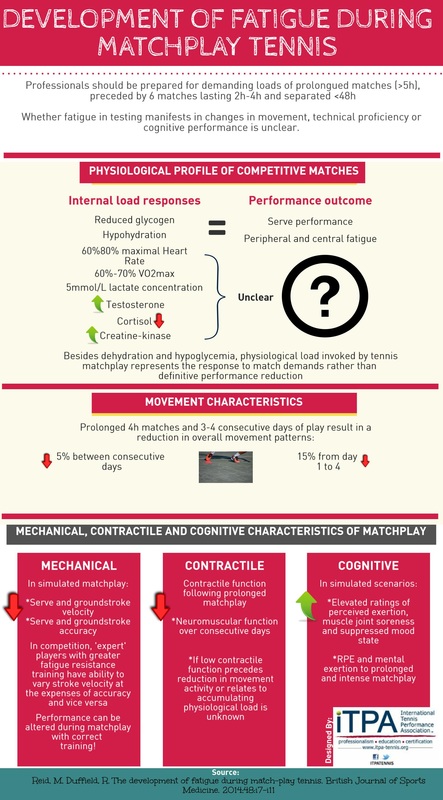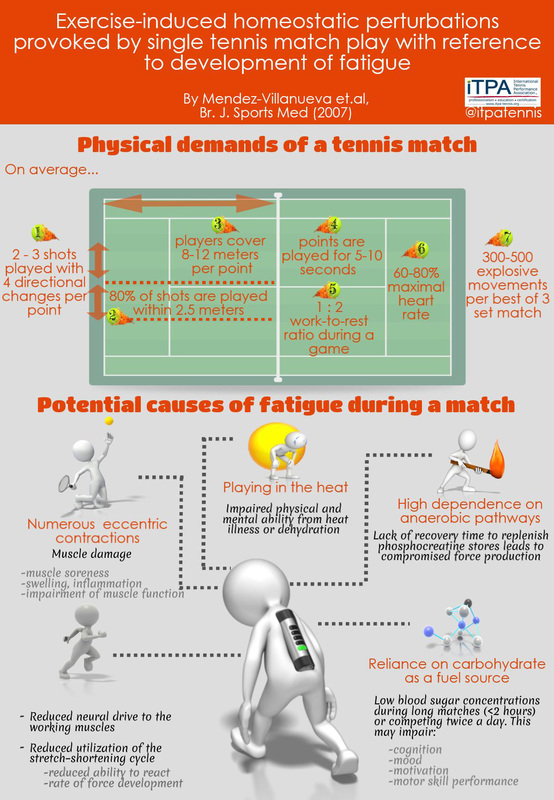Professional players should be prepared for a typical situation that happens during tournament weeks and especially when playing Grand Slams. This involves scenarios of the potential of 4-5+ hour matches and the possibility of playing 7 matches in a two week period, with only 24-49 hours of rest between each match. Fatigue occurs: the challenge for everyone is to determine the amount of fatigue and the impact it has on performance, recovery and possible injury. It’s unclear if players experiment movement changes, poor technique or reduced cognitive performance. Fatigue responses (i.e. an athlete’s physiological profile) can be divided into changes in mechanical, contractile and cognitive characteristics:
Physiological profile:
Researchers have studied internal load parameters that are produced during tennis. This information is summarized briefly below. Most of this data is based on matches lasting 120 minutes or less:
- 60%-70% maximal heart rate.
- 60%-70% maximal oxygen consumption.
- 5mmol/L concentration of lactate.
- Elevated testosterone.
- Elevated creatine kinase.
- Reduced cortisol.
Movement characteristics: Although literature is clear in quantity (around 8-12m per point and 600-800m per set) and duration (<10 seconds per point), movement patterns variations produced by fatigue is unclear. While it’s known that certain technical approaches have different oxygen costs it remains dubious if movement patterns change due to fatigue. Other factors may contribute as well (surface type, game style or tactical decisions). What is confirmed is that over 4 hours of prolonged matchplay and then again after 3-4 consecutive days of matchplay there is a reduction in overall movement patterns: 5% within respective days and 15% from day 1 to day 4. Whether this profile represents fatigue, or alternatively, a deliberate change in game style, isn’t clear and should be investigated in the future.
Changes in mechanical, contractile and cognitive characteristics: Studies have observed decreases in serve and groundstroke velocity during training and matches, as well as following training/matches. Despite these results, previous studies also found that the reductions in velocity were not necessarily accompanied by decrease in accuracy. This suggests that many tennis players adapt to the fatigue, by reducing the pace of the ball, but maintain accuracy. This is makes theoretical sense as it holds to the speed accuracy trade-off. In addition to these results, most of the studies were performed in simulated environments rather than in “real” competition situations. While these findings were unclear to determine if fatigue itself affects mechanical aspects like the groundstrokes, studies also indicate that velocity and accuracy can be altered during matchplay by expert players. With so many doubts, the most appropriate advice we can give and that is supported by these studies is to train for these type environments through a combination of tennis-specific strength training to allow for repeated stroke and movement mechanics over an extended period of time.
Contractile function seems to clearly reduce its function following prolonged tennis matchplay in addition to reduced neuromuscular function, particularly of the lower body, during matchplay greater than 2 hours and over consecutive days of matchplay. If this altered function precedes the reduction in movement activity profiles or relates to the accumulating physiological load remains unknown. A well-organized training program enhancing muscle resistance and function, as well as neuromuscular stimulation, should theoretically result in less reductions of these parameters.
Cognitive aspects such as perception of fatigue are also interesting in which to comment. Simulated and matchplay situations result in elevated ratings of perceived exertion, muscle joint soreness and suppressed mood states. Recent data reveals that cognitive load relates directly to physical exertion of on-court tennis training although few studies report these variables in competitive scenarios. What does seem to be clear is that there is a reduction in motivation that’s part of the fatigue process irrespective of the capacity of the muscle to contract which we’ve discussed above these lines. We can also highlight increased RPE and mental exertion to prolonged matchplay and increased error rates throughout longer or more taxing drills. This may mean that motivation and exertion are affected by the physical state, and thus alterations in stroke play and/or movement patterns. Nevertheless, motivation to perform within research settings is distinct from the motivation to perform within competitive scenarios.
Reference:
Reid, M. Duffield, R. The development of fatigue during match-play tennis. British Journal of Sports Medicine. 2014; 48:i7-i11.






 RSS Feed
RSS Feed
